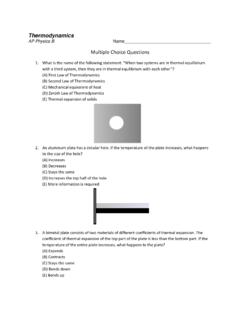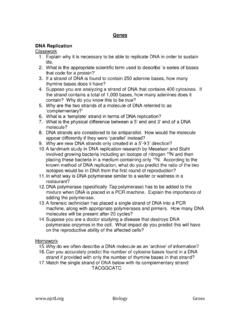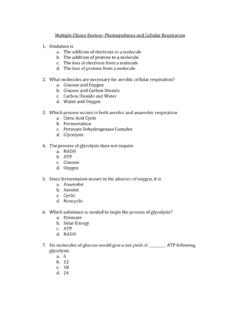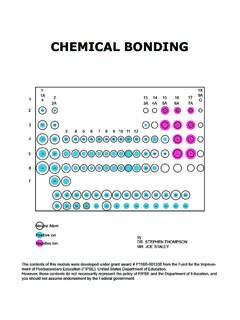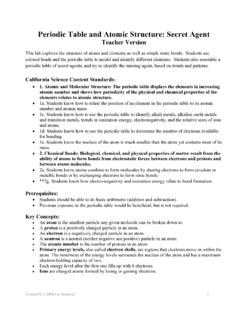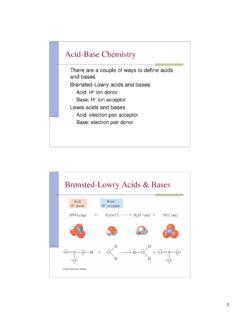Transcription of Periodic Trends Multiple Choice Review PSI Chemistry Name
1 Periodic Trends Multiple Choice Review PSI Chemistry Name_____. Atomic Size 1) Elements Z and X are compared. Element Z is larger than Element X. Based on this you could say: A) Element Z is further to the left side of the Periodic table B) Element X is closer to the top of the Periodic table C) Element Z and X are probably in the same group D) A and/or B. E) B and/or C. 2) Atomic radius generally increases as we move _____. A) down a group and from right to left across a period B) up a group and from left to right across a period C) down a group and from left to right across a period D) up a group and from right to left across a period E) down a group; the period position has no effect 3) The atomic radius of main-group elements generally increases down a group because _____.
2 A) effective nuclear charge increases down a group B) effective nuclear charge decreases down a group C) effective nuclear charge zigzags down a group D) the principal quantum number of the valence orbitals increases E) both effective nuclear charge increases down a group and the principal quantum number of the valence orbitals increases 4) Which one of the following atoms has the largest radius? A) O. B) F. C) S. D) Cl E) Ne 5) Which one of the following atoms has the largest radius? A) Sr B) Ca C) K. D) Rb E) Na 6) Which one of the following has the smallest radius?
3 A) Na B) Cl C) P. D) Br E) K. Periodic Trends Chemistry 7) Which one of the following atoms has the largest radius? A) I. B) Co C) Ba D) Sr E) Ca 8) Which one of the following elements has the largest atomic radius? A) Se B) As C) S. D) Sb E) Te 9) Which one of the following elements has the largest atomic radius? A) O. B) F. C) Al D) P. E) B. 10) In which of the following atoms is the 2s orbital closest to the nucleus? A) S. B) Cl C) P. D) Si E) They are the same distance in all of these atoms. 11) Which of the following correctly lists the five atoms in order of increasing size (smallest to largest)?
4 A) F < K < Ge < Br < Rb B) F < Ge < Br < K < Rb C) F < K < Br < Ge < Rb D) F < Br < Ge < K < Rb E) F < Br < Ge < Rb < K. 12) In which of the following atoms is the 3s orbital closest to the nucleus? A) Br B) Cl C) At D) I. E) They are the same distance in all of these atoms. Periodic Trends Chemistry 13) Which of the following correctly lists the five atoms in order of increasing size (smallest to largest)? A) O < F < S < Mg < Ba B) F < O < S < Mg < Ba C) F < O < S < Ba < Mg D) O < F < S < Ba < Mg E) F < S < O < Mg < Ba Ions and Ionic Size 14) Which ion below has the largest radius?
5 A) Cl - B) K +. C) Br - D) F - E) Na +. 15) The ion with the smallest diameter is _____. A) Br - B) Cl - C) I - D) F - E) O2- 16) The most common sulfur ion has a charge of _____. A) 2- B) 1- C) 4+. D) 6+. E) Sulfur does not form ions. 17) Chlorine is much more apt to exist as an negative ion than is sodium. This is because _____. A) chlorine is bigger than sodium B) chlorine has a greater ionization energy than sodium does C) chlorine has a greater electronegativity than sodium does D) chlorine is a gas and sodium is a solid E) chlorine is more metallic than sodium 18) Sodium is much more apt to exist as a positive ion than is chlorine.
6 This is because _____. A) chlorine is a gas and sodium is a solid B) chlorine has a greater electron affinity than sodium does C) chlorine is bigger than sodium D) chlorine has a greater ionization energy than sodium does E) chlorine is more metallic than sodium Periodic Trends Chemistry 19) Of the following species, _____ has the largest radius. A) Rb +. B) Sr 2+. C) Br - D) Kr E) Ar 20) Which of the following is an isoelectronic series? [ ]. A) B5-, Sr4-, As3-, Te2- B) F -, Cl -, Br -, I - C) S, Cl, Ar, K. D) Si2-, P2-, S2-, Cl2- E) O2-, F -, Ne, Na +.
7 21) Which isoelectronic series is correctly arranged in order of increasing radius? A) K + < Ca2+ < Ar < Cl - B) Cl - < Ar < K + < Ca2+. C) Ca2+ < Ar < K + < Cl - D) Ca2+ < K + < Ar < Cl - E) Ca2+ < K + < Cl - < Ar 22) _____ is isoelectronic with argon and _____ is isoelectronic with neon. A) Cl - , F - B) Cl - , Cl +. C) F +, F- D) Ne-, Kr+. E) Ne-, Ar+. electronegativity 23) The ability of an atom in a molecule to attract electrons is best quantified by the _____. A) paramagnetism B) diamagnetism C) electronegativity D) first ionization potential E) electron change-to-mass ratio 24) electronegativity _____ from left to right within a period and _____ from top to bottom within a group.
8 A) decreases, increases B) increases, increases C) increases, decreases D) stays the same, increases E) increases, stays the same Periodic Trends Chemistry 25) Of the atoms below, _____ is the most electronegative. A) Br B) O. C) Cl D) N. E) F. 26) Of the atoms below, _____ is the most electronegative. A) Si B) Cl C) Rb D) Ca E) S. 27) Of the atoms below, _____ is the least electronegative. A) Rb B) F. C) Si D) Cl E) Ca 28) Which of the elements below has the largest electronegativity ? A) Si B) Mg C) P. D) S. E) Na 29) In general, as you go across a period in the Periodic table from left to right: (1) the atomic radius _____.
9 (2) the electronegativity _____; and (3) the first ionization energy _____. A) decreases, decreases, increases B) increases, increases, decreases C) increases, increases, increases D) decreases, increases, increases E) decreases, increases, decreases Ionization Energy 30) The first ionization energies of the elements _____ as you go from left to right across a period of the Periodic table, and _____ as you go from the bottom to the top of a group in the table. A) increase, increase B) increase, decrease C) decrease, increase D) decrease, decrease E) are completely unpredictable Periodic Trends Chemistry 31) Of the choices below, which gives the order for first ionization energies?
10 A) Cl > S > Al > Ar > Si B) Ar > Cl > S > Si > Al C) Al > Si > S > Cl > Ar D) Cl > S > Al > Si > Ar E) S > Si > Cl > Al > Ar 32) Of the following atoms, which has the largest first ionization energy? A) Br B) O. C) C. D) P. E) I. 33) Of the following elements, which has the largest first ionization energy? A) Na B) Al C) Se D) Cl E) Br 34) Of the following elements, which has the largest first ionization energy? A) K. B) Rb C) Sr D) Ca E) Ba 35) Of the following elements, which has the largest first ionization energy? A) Se B) As C) S.
